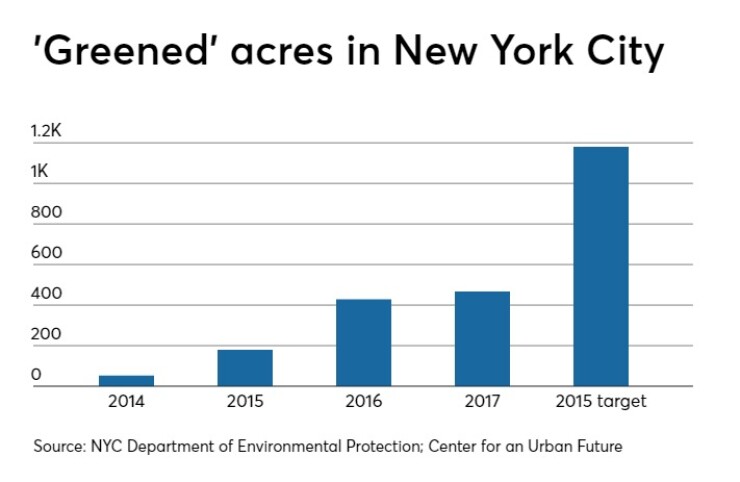Mayor Bill de Blasio’s plan to double the size of New York City’s green infrastructure program includes the construction of more than 5,000 curbside rain gardens in Brooklyn, the Bronx and Queens.
The specially designed curbside rain gardens will absorb millions of gallons of stormwater each time it rains, the mayor and presidential candidate said Wednesday. The city has already constructed more than 4,000 such gardens.

“We are deploying all of the resources at our disposal to tackle the challenge of global warming head-on,” de Blasio said.
According to de Blasio, the initiative is part of the city’s $20 billion strategy to grapple with climate change effects, including extreme rainfall, rising temperatures, storm surge and sea-level rise.
This has included constructing long-term coastal resiliency projects in all five boroughs, implementing a $106 million strategy for extreme heat, partnering with utilities to harden critical infrastructure, and making small businesses more efficient.
Flooding isn’t only a threat in coastal neighborhoods, said Jainey Bavishi, director of the Mayor’s Office of Resiliency.
“As global warming ushers in increasingly intense rainstorms, we’re also taking steps to make our inland communities more resilient," she said.
An impervious surface covers more than 70% of the city’s land mass, which results in massive amounts of stormwater entering the sewer system during rainstorms. Curbside rain gardens aim to soften the city’s landscape and allow natural absorption into the ground.
In addition, some of targeted neighborhoods have less than average street tree counts and higher than average rates of asthma among younger people.
Rain gardens are built in city sidewalks and do not reduce parking spaces, the mayor said. They resemble standard street tree pits, though sizes vary, and have curb cuts that enable stormwater to enter and overflow if it becomes saturated. Engineering enables them to manage up to 2,500 gallons each during a storm.

In partnership with the departments of Transportation and Parks and Recreation, the city's Department of Environmental Protection factors geotechnical investigations and surveys into site selection. Stormwater is absorbed in less than 48 hours.
According to think tank Center for an Urban Future, the city is still struggling to meet the targets set in a 2012 agreement with New York State. That agreement and sets five-year targets for overall stormwater capture, leading to a goal of 1.67 billion gallons per year in combined sewer overflow reduction by 2030.
The center's
City Council member Justin Brannan from Brooklyn said a take-charge posture is essential.
“To sort of rely and assume that someone else is going to do it and you get into this diffusion of responsibility situation, I think is one of the most dangerous pieces of this,” said Brannan, who chairs the council’s new committee on resiliency and waterfronts.





